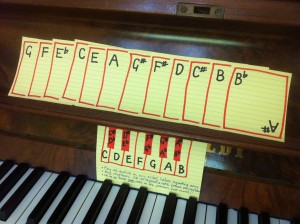 Twelve tone music breaks many of our expectations about music. It removes our sense of what is musically “right” and “wrong” and broadens our repertoire of musical shapes. This makes it a great platform from which to discover and explore musical composition (even for very small children).
Twelve tone music breaks many of our expectations about music. It removes our sense of what is musically “right” and “wrong” and broadens our repertoire of musical shapes. This makes it a great platform from which to discover and explore musical composition (even for very small children).
The Rules of Twelve Tone Music
1) Western music has twelve tones, which are: A, A#, B, C, C#, D, D#, E, F, F#, G and G#.
On a piano keyboard that’s seven white notes and five black notes. The rest of the keyboard is the same notes repeated up/down an octave or more.
2) The twelve tones are played in any order without repeating a tone until they have all been played.
3) A tone can be played in any available octave.
4) Various note lengths, rests, pauses etc may be used.
5) A tone may be played more than once before moving onto the next tone.
6) The tone immediately prior to the current tone may be played again, even to the extent of going backward and forward between the two tones repeatedly before moving on.
7) Do not go back to a note played two-or-more positions previously until the end of the cycle, when all notes become available again.
If this is too much to digest all at once, then start with 1 and 2 (above), and only add the variations mentioned when you want to.
The Simplest Game: Random Composition
You will need a tuned instrument, typically a piano, twelve cards each with the name of a different tone on it, and someone who can read the note names and find them on the instrument.
Shuffle the cards, then lay them out in order, so you can see all the note names. If playing with a young child, allow the child to order the cards.
Play all the notes in order, using allowable variations if you feel like it.
Allow yourself (or the child) to fiddle with the order of the cards if you want to.
You may want to repeat the little tune a few times, playing with the allowable variations, or simply playing it the same way each time, until you feel you are getting to know it.
You may want to add words and sing along. Any words can be used, from existing nursery rhymes to original poetry. Play with the allowable variations to twelve tone music until the words and the tune fit together. Do as many tunes as you feel like.
Use Constraints to Add Interest
You can further shape the music by playing with some arbitrary constraints, such as:
a) use a repeated rhythm (short, short, long x4)
b) use the different octaves to create specific shapes (ascending, descending, changing direction)
c) play adjacent notes quickly, but pause to digest after a leap of more than 5 tones
d) use a repeated pattern of note duplication (1, 2-2, 3, 4-4, 5, 6-6, 7…)
Constraints like these can help you feel comfortable with some familiar shapes in an exercise which is designed to take you outside of your musical comfort zone. If you want to go in the other direction, and lose yourself in the randomness, you can roll dice to allocate note length, rests, note duplication, etc.
Deliberate Composition & Recording
Once you are comfortable with how twelve tone music works, you may want to compose more deliberately and less randomly. The cards can be helpful in keeping track of which notes you have used in the current cycle.
Short tunes can be recorded very easily by digital camera (note order only), audio or video. Use manuscript paper to record longer tunes.
Access to manuscript paper can be a revelation to the child who is learning music, depending on their personality and stage of learning. It allows creativity of a very detailed, deliberate and reproducible sort.
Links
A big thank you to Vihart for her Twelve Tones video on YouTube which explains and demonstrates twelve tone music and plays with all sorts of musical shapes.
